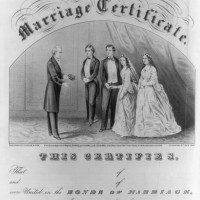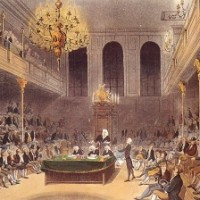4. Then the Council of Trent convened, a fourth major event shaping marital law.
Even as the Reformers increasingly secularized marriage in Protestant states, the Catholic Church reasserted the requirement that Catholic marriages take place in the presence of a priest. Trent also reaffirmed marriage as a sacrament for Catholics. Thus the divide of Protestant versus Catholic widened in the Church and the state gradually stepped in to fill the gap while the Church–Protestant and Catholic– argued about sacraments, divorces, and whether the an institution “for this world” should actually be governed by the Church instead of the state. While the Church argued, increasingly the state governed. There’s a lesson here for us today.
5. A fifth event changing marital law happened with passage of The Clandestine Marriage Bill of 1753 in England.
 A Bill such as this from England might not seem, at first, to be a pivotal event, but the outcome of this act became the general definition of marriage as we’ve known it in the United States since colonial days. According to Eve Tavor Bannet in “The Marriage Act of 1753: A Most Cruel Law for the Fair Sex,” the Bill was presented to the House of Commons to be of particular interest to social elites.
A Bill such as this from England might not seem, at first, to be a pivotal event, but the outcome of this act became the general definition of marriage as we’ve known it in the United States since colonial days. According to Eve Tavor Bannet in “The Marriage Act of 1753: A Most Cruel Law for the Fair Sex,” the Bill was presented to the House of Commons to be of particular interest to social elites.
Bannet writes, “The Government said that the Bill was designed to prevent rich heirs and heiresses of good family from being seduced into clandestine or runaway marriages with their social or economic inferiors.”
The result of the Act was that people would legally be married in “what we now take to be the normal and natural way: with banns or a license and parental permission for minors, before witnesses and an authorized clergyman, and by recording the event in a Marriage Register.”
Prior to this law, common law marriages of a vow (stating the verbum) and consummation were sufficient for marriage and becoming quite common in an Enlightenment culture that exalted the individual freedom and mutual consent over arranged marriage practicalities of politics, power, and property.
To opponents of the Bill, the Government was assigning “the word Marriage…a different signification from what it had before.” The banns, the witnesses, and the Marriage Register were to be part of the definition of what a marriage would be.
To the Bill’s opponents, this was the origin of what today we’d call social engineering.
Bannet writes, “The Marriage Bill of 1753 was one of the first fruits of the new discipline of political economy. It represented the best contemporary thinking about how to manage population in order to increase Britain’s wealth…[and marriages] were the nation’s ‘Manufactory for making Children’ and children had become a ‘source of wealth.’”
Productive wealth. It was viewed that legitimate children would be productive income producers and illegitimate children were unproductive burdens on society. To prevent illegitimacy and to halt polygamy (among men with multiple mistresses and who sired illegitimate children), the Marriage Registry made it possible to track men to ensure that “women could be attached and attributed to a husband, and their children to a father.”
The Marriage Register contained all recorded marriages which, following Lord Hardwicke’s Marriage Act of 1753, were mandated to be conducted by a minister in a parish church or chapel of the Church of England in order for it to be legally binding.
Interestingly Jews and Quakers were exempted from the 1753 Act. But the Act required other religious non-conformists and Catholics to be married in Anglican churches. Do we see the ongoing struggle between Protestants and Catholics as the government steadily built laws?
By 1793 the English Parliament required a church ceremony and a license in order to be considered legally married so that “a marriage could only be recognized by the government,” according to Howard Ball in the Supreme Court in the Intimate Lives of Americans.
 Naturally, all religious non-conformists and Catholics did not like the requirement that true marriages must take place in an Anglican church in order to be recorded in the Marriage Register, so eventually this mandate was resolved by Parliament in the Marriage Act of 1836. This permitted non-conformists and Catholics to be married in their own places of worship.
Naturally, all religious non-conformists and Catholics did not like the requirement that true marriages must take place in an Anglican church in order to be recorded in the Marriage Register, so eventually this mandate was resolved by Parliament in the Marriage Act of 1836. This permitted non-conformists and Catholics to be married in their own places of worship.
It also established non-religious civil marriages to be held in register offices which were set up in towns and cities.
One bad law deserves another and now it seems the Church was being squeezed out of marriage altogether.
Of course the early colonists of America brought some of these ideas with them from England, even if their primary concern was maintaining freedom of religion and civil order in the newly formed States. Ever since, the government in the United States of America has dealt with increasing secularization of marriage law.
The last of the milestone events was the Second Vatican Council which coincided with social upheaval in the United States. See how this impacted marriage law by joining me on the next page.
4 Comments
Barbara, thanks for this insightful and far-reaching essay. very very informative. what were some of the sources that got you thinking about this?
I’m not a prophet, but I have been greatly concerned about the path we are headed on in the US as Christians sit on the sidelines with our hands in our pockets. Afraid of being called “intolerant” or stupid or whatever, we’ve retreated from asking hard theological and legal questions about where the US is going with issues such as (recently) gay marriage, contraception, religious freedom, abortion, health care, etc. I began my Wrong Questions series with Patriarchy, then Rights and Freedom, followed by Marriage and my next article will be an in-depth look at Asking the Wrong Questions about Homosexuality.
All one has to do is listen to the news to see that we are approaching a point of no return. If we don’t change direction, we’re likely to end up where we’re headed.
Oh, and not to leave out the obvious answer to all questions: Jesus! 🙂
God has had me researching marriage for over a month with a stack of books a mile high. Finally, the promptings of the Holy Spirit were starting to keep me awake at night so I pushed the “publish” button. 😀
And one more thought…most of the books I’ve looked at were dealing with the development of the law and religious freedom from a legal perspective in the West (US specifically). Being more of a theology person, I couldn’t help but see these in light of the development of religion.
Don’t you find it interesting that if redefining marriage to include the GLBT relationships was a matter of true civil/human rights, they’d be pursuing this classification worldwide and not just in the Judeo-Christian world? If it’s a human right, why aren’t they pursuing civil marriages for homosexuals in countries that have Islamic ties?